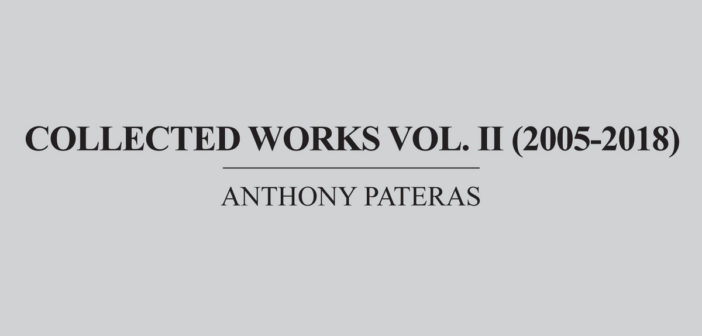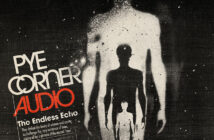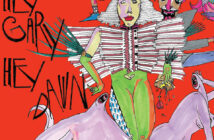If you’re curious to know what Europe based Australian composer Anthony Pateras has been up to for the last five years or so, and if the frequent collaborative editions with everyone from Rohan Drape to Stephen O’Malley haven’t given you some idea, then this box set is a pretty good place to start.
Pateras has always had many strings to his bow, from his frenetic unpredictable electronic work alongside Robin Fox to his improvised trio with Sean Baxter and David Brown to his new music compositional work to pretty much everything else he does, he’s been a pretty restless individual.
What we see here is a taste of that. This 5CD set opens with ‘A Happy Sacrifice’, a duo of tape and contrabass with Australian bassist Jon Heilbron (Austrlian Art Orchestra/ Phonetic Orchestra), a beautiful drone piece. As usual in the liner notes Pateras is candid, describing both a poor recording and then when redoing it the performance that wasn’t up to scratch. “It’s the moment of discovery which is the most important to capture,” he confirms to himself, and its these kinds of avant garde ‘Wonder Years’ observations that give a real insight into his mindset and his restless desire for the new.
He’s constantly searching, like on the difficultly pitched ‘Burning Is The Thing’, a collaboration with Maryanne Amacher who creates ‘sounds that produce sounds from within your ears,’ which is somewhere between an hypnotism and an endurance test. His 11 minute drone piece with Melbourne cellist Judith Hamann is curiously satisfying. When flicking through the liner notes I realise Pateras agrees, “The difference between my recent pieces and the old ones is: I like listening to these ones.”
As you can see this collection is a little like trainspotting. You listen to the piece and then turn to the notation and read a story about its inception, I particularly like the story behind ‘As Long As Breath Or Bow’. It’s a piece for ensemble]h[iatus, this slowly evolving drone that builds texture amidst a few squeals, all held together by a blown out bottom end. The story is about getting the ego bruised, but the 25 minute piece is its own kind of creeping bruise, a wandering ambience that is fascinating in its level of control – particularly when you consider 9 musicians were involved.
The third disc is for trios, and I’m particularly taken with his 25 minute piece with Julia Reidy (guitar) and Bree Van Ryk (Vibraphone). Pateras is of course on prepared piano, and the concept behind the piece is Pateras challenging himself to write something for himself, outside of the commission game. So what does he want to do? Create a big broken music box…for 25 minutes. You have to admire the dedication to the cause.
I’ve always admired Pateras’ motivations. Often he’ll twist and contort himself as a reaction to a reaction. He’s pretty uncompromising. “My only issue with musique concrete is, when there is piano, it’s played incompetently.” It’s hard to disagree (I’m talking about the piano – I’m actually surprised at his restraint re musique concrete). The piece in question is ‘The Sound Sings The Speed’ and he’s simultaneously taking the piss, and using the constraints to make a really fascinating piece. It features 8 prepared pianos and electronics and begins with that sound you hear in your ears when you repeatedly walk headlong into a wall, over and over again. Here the humour comes from the repetition, from the insanity of tying one hand behind his back and working within the extended constraints.
‘Prayer to Nil’, a piece for Soprano voice (Jessica Aszodi) and electronics is particularly interesting. I’d love to hear it not knowing anything about the artist, composer, background or cultural associations. I wonder where I would place it? To me this is the most groundbreaking piece in this collection, it’s quasi devotional, quasi weird with periodic electronic stabs and quasi classical. I’m quasi confused. The delays in this piece in particular are majestic.
The last disc is all about largish ensembles. We’re talking about pieces for 6, 15 or 27 musicians. I wanted to like ‘Artefacts of Translation’ primarily because of his issues with the melodica that he writes about in the notes. Think about that for a second, you have 27 instruments and you can’t work out whether the melodica should be in or out. Finally he writes “The melodica was the thing that made you keep listening,” not only do I want that on a t-shirt, but he’s correct. The melodica in Le Grande Orchestre de Muzzix is great. As it unfolds your realise how immense it is, how many players, but again the restraint is there. It comes in big dense waves and just engulfs you.
This is just a sample of the breadth of the music in this collection. Pateras’ music sounds like nothing else around, including himself, thanks to his desire to endlessly find the new. Yet when combined here you realise it couldn’t be anyone else. There are so many ideas in this collection, so many approaches as Pateras bounces off his collaborators, and continues to create new, absorbing and eternally uncompromising work.




